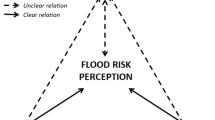Abstract
This study developed an approach to assess the vulnerability to climate change and variability using various group multi-criteria decision-making (MCDM) methods and identified the sources of uncertainty in assessments. MCDM methods include the weighted sum method, one of the most common MCDM methods, the technique for order preference by similarity to ideal solution (TOPSIS), fuzzy-based TOPSIS, TOPSIS in a group-decision environment, and TOPSIS combined with the voting methods (Borda count and Copeland’s methods). The approach was applied to a water-resource system in South Korea, and the assessment was performed at the province level by categorizing water resources into water supply and conservation, flood control and water-quality sectors according to their management objectives. Key indicators for each category were profiled with the Delphi surveys, a series of questionnaires interspersed with controlled opinion feedback. The sectoral vulnerability scores were further aggregated into one composite score for water-resource vulnerability. Rankings among different MCDM methods varied in different degrees, but noticeable differences in the rankings from the fuzzy- and non-fuzzy-based methods suggested that the uncertainty with crisp data, rather widely used, should be acknowledged in vulnerability assessment. Also rankings from the voting-based methods did not differ much from those from non-voting-based (i.e., average-based) methods. Vulnerability rankings varied significantly among the different sectors of the water-resource systems, highlighting the need to assess the vulnerability of water-resource systems according to objectives, even though one composite index is often used for simplicity.

Similar content being viewed by others
References
Adger WN (2006) Vulnerability. Glob Environ Change-Human Policy Dimens 16(3):268–281
Adger W, Brooks N, Kelly M, Bentham G, Agnew M, Eriksen S (2004) New indicators of vulnerability and adaptive capacity. Technical report 7, Tyndall Centre for Climate Change Research, Univ. of East Anglia, Norwich, UK
Bellman RE, Zadeh LA (1970) Decision-making in a fuzzy environment. Manag Sci 17(4):141–164
Brooks N, Adger WN, Kelly PM (2005) The determinants of vulnerability and adaptive capacity at the national level and the implications for adaptation. Glob Environ Change-Human Policy Dimens 15(2):151–163
Chu TC (2002) Facility location selection using fuzzy TOPSIS under group decisions. Int J Uncertain Fuzziness Knowledge-Based Syst 10(6):687–701
Chung ES, Lee KS (2009) Identification of spatial ranking of hydrological vulnerability using multi-criteria decision making techniques: case study of Korea. Water Resour Manag 23(12):2395–2416
Eriksen S, Kelly P (2007) Developing credible vulnerability indicators for climate adaptation policy assessment. Mitig Adapt Strateg Glob Chang 12(4):495–524
Fu GT (2008) A fuzzy optimization method for multicriteria decision making: an application to reservoir flood control operation. Expert Syst Appl 34(1):145–149
Fussel HM, Klein RJT (2006) Climate change vulnerability assessments: an evolution of conceptual thinking. Clim Chang 75(3):301–329
Gleick PH (1990) Global climatic changes. Civ Eng Practice 5(1):53–68
Hamouda MA, El-Din MMN, Moursy FI (2009) Vulnerability assessment of water resources systems in the Eastern Nile Basin. Water Resour Manag 23(13):2697–2725
Hwang CL, Yoon K (1981) Multiple attributes decision-making methods and applications. Heidelberg, Springer
Jun KS, Chung ES, Sung JY, Lee KS (2011) Development of spatial water resources vulnerability index considering climate change impacts. Sci Total Environ 409(24):5228–5242
Jun KS, Chung ES, Kim YG, Kim Y (2013) A fuzzy multi-criteria approach to flood risk vulnerability in South Korea by considering climate change impacts. Expert Syst Appl 40(4):1003–1013
Kim Y, Chung ES (2013) Fuzzy VIKOR approach for assessing the vulnerability of the water supply to climate change and variability in South Korea. doi:10.1016/j.apm.2013.04.040
Lee G, Jun KS, Chung ES (2013) Integrated multi-criteria flood vulnerability approach using fuzzy TOPSIS and Delphi technique. Nat Hazards Earth Syst Sci 13:1293–1312
McCarthy JJ, Canziani OF, Leary NA, Dokken DJ, White KS (2001) Climate change 2001: impacts, adaptation and vulnerability. Cambridge University Press, Cambridge
Moss R, Brenkert A, Malone E (2002) Vulnerability to climate change: a quantitative approach. US Department of Energy, Washington, DC
NIER (2011) Sectoral climate change vulnerability map for guiding the development of climate change adaptation action plan at district level. National Institute of Environmental Research, Kyungseo-Dong, Seo-Gu, Incheon, Korea
O’Brien K, Leichenko R, Kelkar U, Venema H, Aandahl G, Tompkins H, Javed A, Bhadwal S, Barg S, Nygaard L, West J (2004) Mapping vulnerability to multiple stressors: climate change and globalization in India. Glob Environ Change-Human Policy Dimens 14(4):303–313
Saari D (1995) Mathematical complexity of simple economics. Not Am Math Soc 42(2):222–230
Seager J (2001) Perspectives and limitations of indicators in water management. Reg Environ Chang 2(2):85–92
Shih HS, Wang CH, Lee ES (2004) A multiattribute GDSS for aiding problem-solving. Math Comput Model 39(11–12):1397–1412
Shih H-S, Shyur H-J, Lee ES (2007) An extension of TOPSIS for group decision making. Math Comput Model 45(7–8):801–813
Zhou HC, Wang GL, Yang Q (1999) A multi-objective fuzzy pattern recognition model for assessing groundwater vulnerability based on the DRASTIC system. Hydrols Sci 44(4):611–618
Acknowledgments
This study was supported by grants from the Climate Change Correspondence R&D Program funded by Korea Ministry of Environment (RE201206045) and the Advanced Water Management Research Program funded by Korea Ministry of Land, Infrastructure and Transport (12-TI-C01)
Author information
Authors and Affiliations
Corresponding author
Electronic supplementary material
Below is the link to the electronic supplementary material.
ESM
(PDF 968 kb)
Rights and permissions
About this article
Cite this article
Kim, Y., Chung, ES. Assessing climate change vulnerability with group multi-criteria decision making approaches. Climatic Change 121, 301–315 (2013). https://doi.org/10.1007/s10584-013-0879-0
Received:
Accepted:
Published:
Issue Date:
DOI: https://doi.org/10.1007/s10584-013-0879-0




